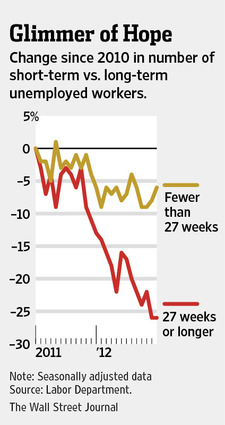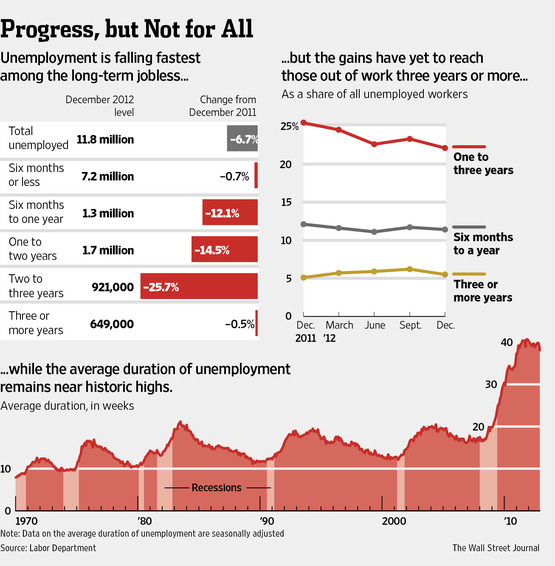A Few Reasons Why I’m Bullish On Obama AND The US Economy
Today, A New Grassroots Organization Is Being Launched: Organizing For Action:
Following in the footsteps of the campaign we built, organizing for action will be an unparalleled force in American politics. It will work to turn our shared values into legislative action — and it’ll empower the next generation of leaders in our movement. A Few Reasons Why I’m Bullish On Obama AND The US Economy
Michelle Obama recorded the video (above) to tell us more about the new organization — take a look and let OFA know you’re in.
We may have started this as a long shot presidential primary campaign in 2007, but it’s always been about more than just winning an election. Together, we’ve made our communities stronger, we’ve fought for historic legislation, and we’ve brought more people than ever before into the political process.
We have the power to do even more to change our politics and our country for the better. With organizing for action, we’ll have every resource we need to do it.
Organizing for Action will support the legislative agenda we voted on, train the next generation of grassroots organizers and leaders, and organize around local issues in our communities.
But it starts with us. This new organization is in our hands.
I’m so excited to see what we’ll do next — and so grateful to be part of it.
Over the next four years, we ‘ ve got an incredible opportunity to keep moving this country forward. This grassroots movement has shown time and again that ordinary people have the power to change our country if we work together to do it.
So locally and nationally, OFA will fight for our shared values on issues like immigration reform, climate change, gun violence, balanced deficit reduction, and more.
We ‘ ll be working together to write a plan for 2013. This organization will be volunteer-led, always guided by the core principles of “respect, empower, include.”
With the launch of Organizing for Action, this grassroots movement is making a permanent commitment to keep moving this country forward. That’ll take all of us. Can you ask your friends to get involved, too?
You can even use the email contact importer (provided by the official Barack Obama website). Don’t worry — they won’t hang onto any of the addresses we provide.
Make sure your friends and family know about Organizing for Action, and ask them to add their names now to get involved.
Oil Boom Spurs New Investment

The Number Of Oil-Laden Tanker Trains Has Grown, As Has The Number Of River Barges Pushed By Tugboats Down The Mississippi River. Here Rail Tanker Cars Sit Lined Up In Corpus Christi, Texas.
Surging energy production in North America is prompting billions of dollars of investment next year on pipelines and other infrastructure projects to move oil and gas around the continent.
The existing U.S. pipeline network isn’t configured to fully serve the new production areas in the center of the country, from North Dakota to South Texas, where oil and natural gas production have started booming. As a result, companies are finding creative ways to move those fuels to market, including a return to early 1900s favorites: iron horse and barge.
The number of oil-laden tanker trains has grown, as has the number of river barges pushed by tugboats down the Mississippi River. Oil pipelines that once pumped crude north from the Gulf Coast increasingly are being reconfigured to flow south to refineries there.
Some natural gas pipelines originally built to ship fuel from the Rocky Mountains and Gulf to the East Coast are little used because of new natural gas discoveries in Pennsylvania. Those pipelines are being considered for conversion to handle oil.

“Our infrastructure over the past 40 years has been set up for this idea of the U.S. as an energy-deficit nation,” said Joseph Stanislaw, an independent senior energy adviser to Deloitte LLP. “Now we have this tectonic shift where we can become an energy surplus nation. That means we have to transform, upgrade and rearrange our logistics.”
AECOM Technology Corp., a firm that does industrial project design, management and engineering, forecasts that in 2013 as much as $45 billion may be spent on new or expanded transportation infrastructure, including pipelines, rail cars, rail terminals and other projects, said Seth Deutsch, an AECOM senior vice president.
The changes are a boon to railroads, rail car builders and companies that own and operate terminals for loading and unloading crude. BNSF Railway, owned by Berkshire Hathaway Inc., has boosted its oil-hauling capacity from North Dakota and Montana to nearly 90 million barrels this year from 1.3 million in 2008. Trinity Industries Inc., a manufacturer of rail cars has raised new-car deliveries this year and boosted its lease-car fleet by 18% since 2000. U.S. Development Group LLC, a oil-terminals firm, opened a new terminal in a Texas shale region this year while expanding its St. James, La., terminal.
Over the past four years, domestic oil and gas production has surged thanks to a combination of technologies, namely hydraulic fracturing and horizontal drilling, which are unlocking deposits trapped in shale-rock formations throughout the country.
There is so much new crude oil production in the central U.S. that a barrel of crude bought at a key distribution hub in Oklahoma can cost some $27 less than an overseas barrel. That has U.S. buyers exploring new avenues to fill up with the cheaper domestic crude.
“We’re moving crude all over the place,” said Bill Day, spokesman for Valero Energy Corp., the world’s largest independent refiner, which this year began shipping 40,000 barrels a day from North Dakota via rail-and-pipeline combination to its Memphis, Tenn., refinery. It also is considering rail shipments of that oil to California.
Rail cars are proving especially useful for moving crude from the oil fields to consumers where there are few pipelines in place able to handle the load. In 2008, there were about 9,500 tanker carloads of oil shipped in the U.S., according to the Association of American Railroads, but by 2011 it had jumped to 66,000 carloads and this year it is expected to top 200,000 carloads.
Moving oil via water is also on the rise. Oil shipments by barge from the northern U.S. to the Gulf Coast grew to 15.3 million in 2011 from about 3.8 million barrels in 2008, and will likely top that this year.
Shipping oil via rail is typically more expensive than by pipeline, however. Loading and unloading rail cars can add as much as $4.50 to the price of a barrel of oil, according to data provided by Marathon Petroleum Corp. The transportation costs of moving oil from North Dakota to the East Coast can add up to $10 a barrel. Even so, the delivered crude can still be less expensive than importing it from overseas.
Another factor in gains by rail transport: New pipeline construction faces legal and permitting challenges from environmental groups. Local opposition has prevented pipelines from connecting oil fields in the middle of the country to refineries on the east and west coasts, said Brad Olsen, an analyst with Tudor, Pickering, Holt and Co. “As long as there are no pipes to replace imported high-cost oil on coasts, rail is the only option.”
Growing resistance to new pipeline projects makes the use of existing pipelines more attractive, industry officials say. Last summer, Enterprise Products Partners LP and Enbridge Inc. ENB.T completed work reversing the Seaway Pipeline so it carries crude oil south to Texas instead of north to Oklahoma.
Houston-based pipeline giant Kinder Morgan Inc. said it is considering taking an underused section of natural gas pipeline that runs from West Texas to California and converting it to an oil pipeline. TransCanada Corp. is gauging interest in a similar conversion in Canada.
Spectra Energy Corp. of Houston acknowledged the regulatory challenges recently when it paid $1.25 billion for the 1,700 mile Express-Platte pipeline that can ship up to 280,000 barrel a day of Canadian crude to the U.S. Midwest.
“The fact that these assets are in the ground already is a huge advantage,” CEO Greg Ebel said in a call with investors.
Long-Term Jobless Begin to Find Work
The epidemic of long-term unemployment, one of the most pernicious and persistent challenges bedeviling the U.S. economy, is finally showing signs of easing.

The long-term unemployed–those out of work more than six months–made up 39.1% of all job seekers in December, according to the Labor Department, the first time that figure has dropped below 40% in more than three years.
The problem is far from solved. Nearly 4.8 million Americans have been out of work for more than six months, down from a peak of more than 6.5 million in 2010 but still a level without precedent since World War II.
The recent signs of progress mark a reversal from earlier in the recovery, when long-term unemployment proved resistant to improvement elsewhere in the labor market.
Total unemployment peaked in late 2009 and has dropped relatively steadily since then, while the number of long-term unemployed continued to rise into 2010 and then fell only slowly through much of 2011.
More recently, however, unemployment has fallen more quickly among the long-term jobless than among the broader population. In the past year, the number of long-term unemployed workers has dropped by 830,000, accounting for nearly the entire 843,000-person drop in overall joblessness.

Michael Leahy, a bank executive in Connecticut,
found a new post in December
after losing his job in 2010.
When Michael Leahy lost his job as a manager at a Connecticut bank in 2010, the state had already shed about 10,000 financial-sector jobs in the previous two years and he had difficulty even landing an interview. By the time banks started hiring again, Mr. Leahy, now 59, had been out of work for more than a year and found himself getting passed over for candidates with jobs or ones who had been laid off more recently.
In July, however, Mr. Leahy was accepted into a program for the long-term unemployed run by the Work Place, a local workforce development agency. The program helped Mr. Leahy improve his resume and interviewing skills, and ultimately connected him with a local bank that was hiring.
Mr. Leahy began a new job in December. The chance to work again in his chosen field, he said, was more than worth the roughly 15% pay cut from his previous job.
“The thing that surprised me is this positive feeling I have every day of getting up in the morning and knowing I have a place to go to and a place where people are waiting for me,” Mr. Leahy said.
The decline in long-term unemployment is good news for the broader economy. Many economists, including Federal Reserve Chairman Ben Bernanke, feared that many long-term unemployed workers would become permanently unemployable, creating a “structural” unemployment problem akin to what Europe suffered in the 1980s. But those fears are beginning to recede along with the ranks of the long-term unemployed.
“I don’t think it’s the case that the long-term unemployed are no longer employable,” said Omair Sharif, an economist for RBS Securities Inc. “In fact, they’ve been the ones getting the jobs.”
Not all the drop in long-term joblessness can be attributed to workers finding positions. In recent years, millions of Americans have given up looking for work, at which point they no longer count as “unemployed” in official statistics.
The recent drop in long-term unemployment, however, doesn’t appear to be due to such dropouts. The number of people who aren’t in the labor force but say they want a job has risen by only about 400,000 in the past year, while the number of Americans with jobs has risen by 2.4 million. That suggests at least much of the improvement is due to people finding jobs, not dropping out, Mr. Sharif said.
The average unemployed worker has now been looking for 38 weeks, down from a peak of nearly 41 weeks and the lowest level since early 2011.
The long-term unemployed still face grim odds of finding work. About 10% of long-term job seekers found work in April, the most recent month for which a detailed breakdown is available, compared with about a quarter of more recently laid-off workers. The ranks of the short-term jobless are more quickly refreshed by newly laid-off workers, however. As a result, the total number of short-term unemployed has fallen more slowly in recent months, even though individual workers still stand a far better chance of finding work early in their search.
And when the long-term unemployed do find work, their new jobs generally pay less than their old ones–often much less. A recent study from economists at Boston University, Columbia University and the Institute for Employment Research found that every additional year out of work reduces workers’ wages when they do find a job by 11%.
Moreover, the recent gains have yet to reach the longest of the long-term unemployed: While the number of people unemployed for between six months and two years has fallen by 12% in the past year, the ranks of those jobless for three years or longer has barely budged at all.
Patricia Soprych, a 51-year-old widow in Skokie, Ill., recently got a job as a grocery-store cashier after more than a year of looking for work. But the job is part-time and pays the minimum wage, which she finds barely enough to make ends meet.
“You say the job market’s getting better. Yeah, for these $8.25-an-hour jobs,” Ms. Soprych said.
Economists cite several reasons for the drop in long-term unemployment. Most significant is the gradual healing of the broader labor market, which has seen the unemployment rate drop to 7.8% in December from a high of 10% in 2009. After initially benefiting mostly the more recently laid-off, that progress is now being felt among the longer-term jobless as well.
The gradual strengthening in the housing market could lead to more improvement. Many of the long-term unemployed are former construction workers who lost jobs when the housing bubble burst. Rising home building has yet to lead to a surge in construction employment, but many experts expect hiring to pick up in 2013.
Another possible factor behind the recent progress: the gradual reduction in emergency unemployment benefits available to laid-off workers. During the recession, Congress extended unemployment benefits to as long as 99 weeks in some states. Today, benefits last 73 weeks at most, and less time in many states. Research suggests that unemployment payments lead some recipients not to look as hard for jobs, and the loss of benefits may have pushed some job seekers to accept work they might otherwise have rejected, said Gary Burtless, an economist at the Brookings Institution.
Housing Accelerates in Boost to U.S. Expansion: Economy

Are Spurring Homebuyer Traffic For The Market
That Triggered The Latest Recession.Click Here For Housing Starts Video
The rebound in U.S. homebuilding accelerated in December, capping the best year for the industry since 2008 and adding to signs residential real estate is contributing to economic growth.
Housing starts climbed 12.1 percent last month to a 954,000 annual rate, exceeding all forecasts in a Bloomberg survey of economists, according to Commerce Department data today in Washington.
Other reports showed fewer Americans applied for jobless benefits last week and manufacturing in the Philadelphia region unexpectedly contracted in January.
Spurred by record-low mortgage rates, home construction will probably keep making headway in 2013 as it recovers from the worst slump since the Great Depression. Consumers, buttressed by an improving job market, rising home prices and lower fuel costs, may also be able to move ahead even as the debate over the federal budget heats up and taxes cut paychecks.
“Housing clearly continues to be one of the bright spots in an otherwise gloomy and sluggish economic-growth story,” said Anika Khan, a senior economist at Wells Fargo Securities LLC in Charlotte, North Carolina, a subsidiary of the largest U.S. mortgage lender. “On the labor market side of things, we continue to get overall positive momentum.”
The number of Americans filing first-time claims for unemployment insurance payments fell last week to the lowest level in five years, pointing to further improvement in the labor market, figures from the Labor Department also showed.
Fewer Claims
Applications for jobless benefits decreased by 37,000 to 335,000 in the week ended Jan. 12, the fewest since January 2008. Economists forecast 369,000 claims, according to the median estimate in a Bloomberg survey. A spokesman for the agency said the drop may reflect the difficulty the government has in adjusting the data at the beginning of quarters and following the holidays when seasonal workers are let go.
Stocks rallied, sending the Standard and Poor’s 500 Index to a five-year high, on the better-than-forecast housing and claims data. The S and P 500 climbed 0.6 percent to 1,480.94 at the close in New York.
Last month’s jump brought housing starts to the highest level since June 2008, the Commerce Department report showed.
For all of last year, work began on 780,000 houses, up from 608,800 in 2011 and also the most since 2008. The 28.1 percent jump from 2011 was the biggest annual gain since 1983.
The median estimate of 84 economists surveyed by Bloomberg called for an increase to 890,000 starts. Projections ranged from 850,000 to 930,000. The prior month was revised down to an 851,000 pace from a previously reported 861,000 rate.
Permits Stable
Building permits, a proxy for future construction, climbed less than starts, indicating the industry may also have gotten a lift from unseasonably warm weather, a sign that the industry will take a breather in coming months. The number of authorizations issued climbed 0.3 percent in December to a 903,000 annual rate, the most since July 2008, from a 900,000 pace in November.
Last month was the second-warmest December in U.S. records going back to 1958, according to the National Oceanic and Atmospheric Administration.
“Starts may have gotten an assist from the unseasonably mild December weather,” Daniel Silver, an economist at JPMorgan Chase and Co. in New York, said in a note to clients. “But the housing data had clearly been improving prior to the unusual temperatures and most other housing indicators have remained upbeat lately. Our forecast still looks for solid growth in residential investment throughout 2013, though levels of activity should remain low by historic standards.”
Housing Boom
Housing starts remain short of the 2.07 million in 2005 at the peak of the boom, which was three-decade high. They averaged 1.74 million a year from 2000 through 2004.
All four regions of the country showed a gain in starts last month, led by a 24.7 percent surge in the Midwest.
Construction of single-family houses climbed 8.1 percent in December from the prior month, to the highest level since June 2008. Work on multifamily homes jumped 20.3 percent.
Confidence among homebuilders held in January at the highest level since April 2006, the National Association of Home Builders/Wells Fargo reported yesterday. The group’s gauge of buyer traffic also climbed to a more than six-year high.
Lennar Corp. (LEN), the largest U.S. homebuilder by market value, is leveraging rental demand by pledging to construct $1 billion of multifamily properties in an attempt to diversify its offerings.
Rental Units
The Miami-based company plans to start building 3,000 apartments at a development cost of $560 million this year, Chief Executive Officer Stuart Miller said earlier this week on a conference call. The first projects are a $36 million, 316- unit community in Jacksonville, Florida, in partnership with Carlyle Group LP, and a $32 million, 264-unit community northeast of Atlanta.
“As demand for new-sale housing continues to increase from historically low levels, rental demand has continued to grow, fueled by expanding household formations, credit and down payment-challenged homebuyers and steadily improving employment,” Miller said on the call.
Cheaper borrowing costs are attracting home buyers who have adequate credit. The average rate on a 30-year fixed purchase loan was 3.40 percent in the week ended Jan. 10, compared to 3.89 percent a year ago, according to McLean, Virginia-based Freddie Mac.
Job creation held steady in December, with the 155,000 workers added to payrolls in line with the year’s average monthly growth rate of 153,000 jobs, Labor Department data show. That progress brought unemployment to 7.8 percent at the end of 2013, down from 8.3 percent at the start of the year.
Payroll Tax
A hurdle for the labor market may come from a higher payroll tax that damps consumers’ spending power. As part of its budget agreement on Jan. 1, Congress agreed to let the tax, used to pay for Social Security benefits, return to its 2010 level of 6.2 percent from 4.2 percent. That reduces the paycheck by about $83 a month for someone who earns $50,000.
Americans’ economic outlook deteriorated in January to a three-month low as paychecks began reflecting the higher taxes, another report today showed.
The gap between positive and negative expectations widened to minus 7 this month from zero in December as the share saying the economy is improving dropped to the lowest since September, according to the Bloomberg Consumer Comfort Index. The weekly measure declined to minus 35.5, the weakest since Oct. 7, from minus 34.4 in the prior period.
Regional Manufacturing
Also today, the Federal Reserve Bank of Philadelphia’s general economic index dropped to minus 5.8 from 4.6 in December. Readings lower than zero signal manufacturing in the area covering eastern Pennsylvania, southern New Jersey and Delaware is contracting.
The report follows New York Fed data released earlier this week showing factory activity shrank for a sixth straight month and raises the risk manufacturing, once a pillar of the recovery, will again weaken in early 2013. Looming changes in federal spending and stagnant prices give companies little reason to expand inventories, which may hurt producers.
“Manufacturing is going to be touch-and-go over the next few months until we get some fiscal clarity,” said Ryan Sweet, a senior economist at Moody’s Analytics Inc. in West Chester, Pennsylvania, the only economist in the Bloomberg survey to project the index would turn negative. The New York and Philadelphia surveys are “a sign that the fiscal deal struck on New Year’s was a good first step, but it didn’t reduce the uncertainty.”
Boat Sales Rev Back To Life
Don Lorenz decided to hold off on splurging on a new boat until he was convinced the economy had stabilized.
The right moment came this summer, when the 63-year-old chief investment officer for a real-estate firm paid $75,000 for a 20-foot water-skiing boat for his family’s lake trips in Northern California.
“I wouldn’t have bought one earlier because the recession and uncertainty were severe,” said Mr. Lorenz, a resident of Menlo Park, Calif., who last bought a boat eight years ago and plans to keep using it, in addition to the new one. “I was trying to maintain my liquidity.”
Boaters gather in San Francisco before the first game of the World Series between the San Francisco Giants and the Detroit Tigers in October.
Buyers like Mr. Lorenz are helping to drive a boating recovery in California. Sales of powerboats are revving up in the state for the first time in five years, part of a national resurgence in a corner of the luxury sector that signals the economy is improving.
Sales of individual boats in California grew 2% to 3% in 2012 from the previous year, said Dave Geoffroy, a vice president of the National Marine Manufacturers Association, marking the first increase since California’s boating industry began a long swoon in 2007.
The California rebound is lagging behind an earlier, sharper recovery for powerboat sales nationwide, which grew 10% in 2012, according to unofficial estimates by the Chicago-based trade group.
The U.S. boating industry generates about $30 billion in annual revenue, with powerboat sales a closely watched segment because they often shrink early in a recession and rebound late, said Thom Dammrich, president of the National Marine Manufacturers Association . Unit sales nationally fell 48% to 142,330 in 2010 from 274,100 in 2007, then inched up to 142,830 in 2011 and rallied to 157,000 in 2012, the group estimates.
In Lake Geneva, Wis., sales of new and used powerboats at Gordy’s Marine jumped 10% this year from 2011, after falling every year since 2008, said Tom Whowell, the store’s owner. ” People have seen the world is not ending, that getting a boat is an important part of [their] family’s escape ,” Mr. Whowell said.
In 2007, California ranked third in the country in new-boat sales, recording $976.9 million in revenue and trailing only Texas and Florida, according to the National Marine Manufacturers Association. By 2010, the most recent year comparisons between states are available, California had fallen to 11th place, with sales of $310.3 million.
The slower rebound in boat sales mirrors California’s patchier overall recovery compared to most other states. The Golden State’s 9.8% unemployment rate for November, though down considerably from a 2010 peak of 12.4%, remained above the national rate of 7.7%, according to estimates by the Bureau of Labor Statistics.
Some boat dealers in coastal cities with stronger economies saw a rebound earlier than those farther from the ocean.
Sun Country Marine Inc. of Ontario, Calif.–an inland city east of Los Angeles–returned to profitability in 2012, the first time in five years it was in the black, said president Mike Basso Jr. The dealership, which offers boats ranging in price from $30,000 to $2 million, sold 300 new and used boats this year, or almost 100 more than in 2011, Mr. Basso said.
Sun Country had already boosted its boat sales in 2011 from a low mark of about 100 in 2009, but relied on price cuts to drive unit sales higher. This time, Mr. Basso said, the dealership managed to increase unit sales while also raising prices about 5%. The dealership, which sold 700 boats in 2007, broke even last year after losing money between 2007 and 2010.
” I think people have increased savings,” Mr. Basso said, “and have a little bit of discretionary income they didn’t have before .”
Fed Finds Economy Improving Across U.S. All 12 Districts Report Growth Despite Fiscal Cliff
The nation’s economy proved surprisingly resilient the past six weeks despite the budget standoff in Congress, with activity expanding in all 12 Federal Reserve districts, the Fed said Wednesday.
The Fed’s beige book report said the New York and Philadelphia Federal Reserve bank districts have rebounded from the near-term effects of Superstorm Sandy, and the pace of growth picked up in the Boston, Richmond and Atlanta regions while slowing in St. Louis.
Still, uncertainty among businesses because of the so-called fiscal cliff of tax increases and spending cuts — which was partially resolved early this month — dampened the retail outlook in some areas and prompted some employers to hold off hiring. And the economic slowdown in Europe hampered some manufacturing exports.
Consumer spending increased across the country, but holiday sales were somewhat disappointing in the New York, Cleveland, Atlanta, Chicago and San Francisco districts.
Government figures released this week show holiday sales rose 2.7% over last year, far less than the 5.5% pace of 2010 and 2011. Sales of clothing, shoes and furniture were brisk in Boston, while online sales were strong in San Francisco. But retail sales were flat in the Richmond area and the fiscal cliff dampened the outlook in the Philadelphia, Kansas City and Dallas regions.
Auto sales, however, remain a bright spot, with sales steady or stronger in 10 districts. Tourism rebounded in the Mid-Atlantic and Northeast following the storm. And tourism in Boston, Atlanta and San Francisco was bolstered by surging business and international travel.
Manufacturing, however, was mixed, with six districts growing, three contracting and two reporting little or no change. Rising aerospace and chemical production fueled growth in the Boston, San Francisco and Dallas districts. And the resurgent auto and housing sectors helped support manufacturing in Chicago and Philadelphia.
But uncertainty about the fiscal cliff tempered growth in the Richmond area. And steel and auto production slowed in Cleveland.
Overall, however, manufacturers were optimistic about coming months in New York, Philadelphia, Atlanta, Minneapolis and Kansas City. The Fed separately reported Wednesday that manufacturing output rose 0.8% in December following a 1.3% gain in November, capping the best two-month stretch of the year.
The housing market also continued its comeback, with activity increasing and prices rising in most districts. Low interest rates and affordable prices sparked home sales in Boston. Still, the hotter market is creating some bottlenecks, with Kansas City reporting higher lumber and drywall costs that limited construction. In New York, the storm initially disrupted construction activity, “but this has since led to increased work for subcontractors on repairs and reconstruction.”
Go back


Leave a Reply
You must be logged in to post a comment.